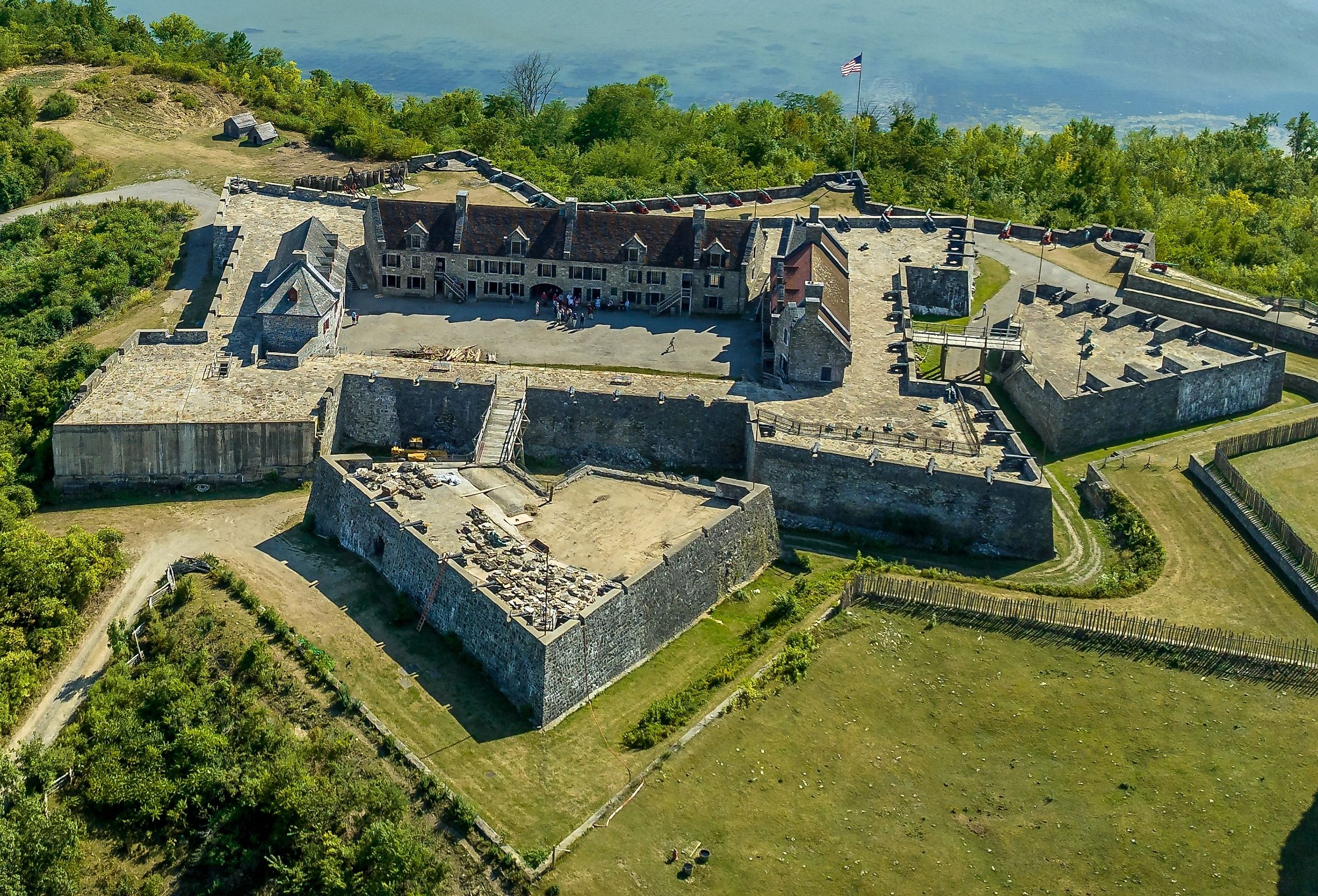
7 of the Most Beautiful Historic Towns in the Adirondacks
The presence of people in the Adirondack Mountains dates back more than 10,000 years. For much of that time, people lived and moved within the mountains according to the needs of the land and the rhythms of the seasonal resources. Later, permanent and sizable settlements developed around the waterways at lower elevations, and these also relied on the mountains for hunting and other resources. The water route through the mountains has long been a crucial travel and trade route for anyone making their way into, out of, or through the area.
When Europeans arrived in larger numbers, the Haudenosaunee (members of the Iroquois Confederacy) were sharing the Adirondack Mountains as a neutral territory with their allies and other friendly groups. During the 1600s, this came to include Europeans, mainly the French. By the 1700s, Lake George and Lake Champlain, specifically, had become crucial trade routes for goods between New York Harbor and Canada, and settlements and military posts were built on their shores.
Today, there are countless towns in the Adirondack area, taking advantage of the natural landscape as people have for generations. And around 3,000 Akwesasne are living at what is federally recognized as the St. Regis Mohawk Reservation in Franklin County.
Learn more about the most historic towns in the Adirondack Mountains.
Ticonderoga

Because of the importance of water travel, many of the Adirondack’s historic sites involve one of the lakes or rivers. In this case, the town and fort named Ticonderoga is at the south end of Lake Champlain, from the Haudenosaunee (Iroquois) word tekontaró:ken meaning "it is at the junction of two waterways."
During the 1700s, the lake was a crucial trading route. The distinctive star-shaped fort, originally known as Fort Carillon, was built by the French during the battles of the French and Indian Wars in the 1750s. When the British Army captured it, they changed the name to Ticonderoga.
The fort later played a pivotal role in the Revolutionary War. It was the site of what many consider America’s first victory when Benedict Arnold and Ethan Allen captured it from the British and shipped its canons and other supplies south to force the British to end the Siege of Boston.
After it was abandoned, the locals used the stone to build their homes and buildings. The site was also used as a vacation home for a while until 1909, when it opened to the public. It has become a major tourist destination. It now houses a museum and hosts tours, interpretive programs, reenactments, and boat cruises on Lake Champlain to over 75,000 guests annually.
The nearby town of Ticonderoga houses a heritage museum originally built in 1888. The Ticonderoga Historical Society also maintains the Hancock House, a lavish reproduction of the original three-story dwelling. Also in town is the Liberty Monument, a 26-foot-tall bronze sculpture memorializing the Battle of Ticonderoga. It features Lady Liberty and four figures representing the roles played by four crucial groups in the area’s military history: the local Indigenous peoples, Americans, the French, and the Scottish.
Lake George
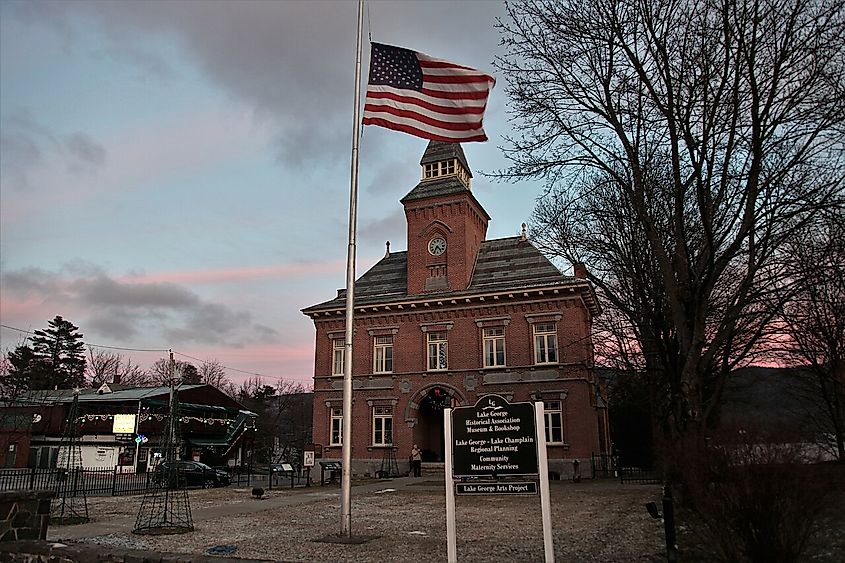
Like Lake Champlain, Lake George was of major importance to commerce in the 1700s. The Lake George Battlefield Park Historic District can be found at the southernmost end of the lake, and its 35 acres preserve sites from the French and Indian War as well as the Revolutionary War.
In the 1800s, the town of Lake George became a summer destination for the richest people in the state, especially the industrialists who made their fortunes in the later part of the century. Everyone from John D. Rockefeller to Georgia O’Keefe came to enjoy the atmospheric forests, cool dark blue water, and rugged peaks of the area. The Lake George Steamboat Company began offering daily excursions in 1817. The unique Wiawaka Center for Women, a retreat for women, dates back to 1903 and still offers free tours of its gardens, buildings, and surroundings.
The most famous historical spot in the region is The Sagamore, a palatial building on a 70-acre private island off the lake’s western shore. Opened in 1883, it was the destination for magnates and tycoons of the time. Renovated and expanded over the years, the luxury resort is now on the National Register of Historic Places and includes a spa, multiple restaurants, and an 18-hole golf course.
Saranac Lake
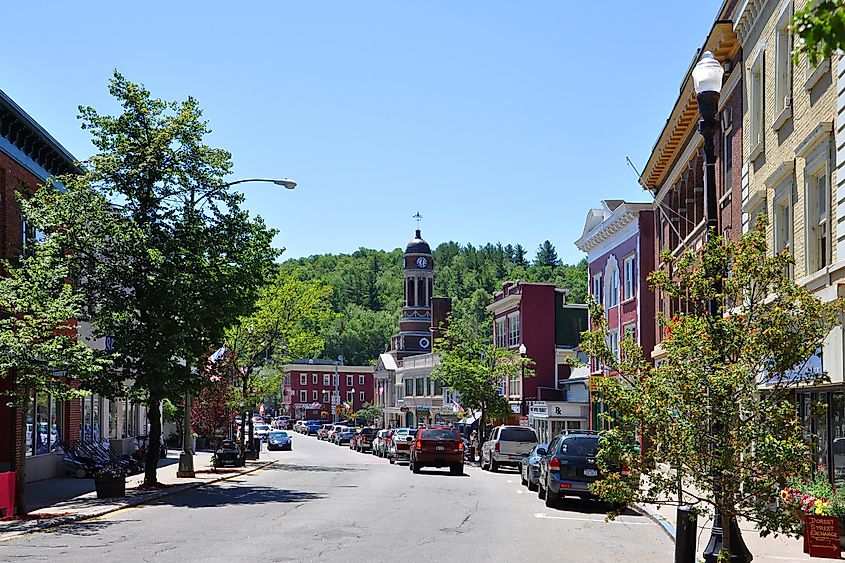
Another town that appealed to the well-off of the Gilded Age was Saranac Lake. It was here that big names like Guggenheim and Vanderbilt families founded their famous Great Camps to enjoy a picturesque rustic getaway without sacrificing their most beloved comforts. The only one of these Great Camps now open to the public is The Point. Originally known as Camp Wonundra, it was built by William Rockefeller Jr. in the early 1930s. It is a compound of log mansions built from local stone and timber that is now the only destination in upstate New York that’s earned the rank of a Forbes Five Star property. It still offers luxurious all-inclusive services, restaurants, black-tie events, boutiques, and galleries.
Saranac Lake’s climate is similar to the alpine resorts popular in Europe for those ailing from diseases like tuberculosis. As such, in the late 1800s, it was a popular place for health resorts and the site of the first dedicated tuberculosis lab in the US: the Saranac Laboratory Museum. Fans of Robert Louis Stevenson, author of Treasure Island, can visit the Saranac Lake cottage where he convalesced in the 1880s.
Other famous visitors to Saranac Lake include Albert Einstein and Béla Bartók, who composed two concertos there. It was also immortalized by Sylvia Plath in The Bell Jar.
Paul Smiths
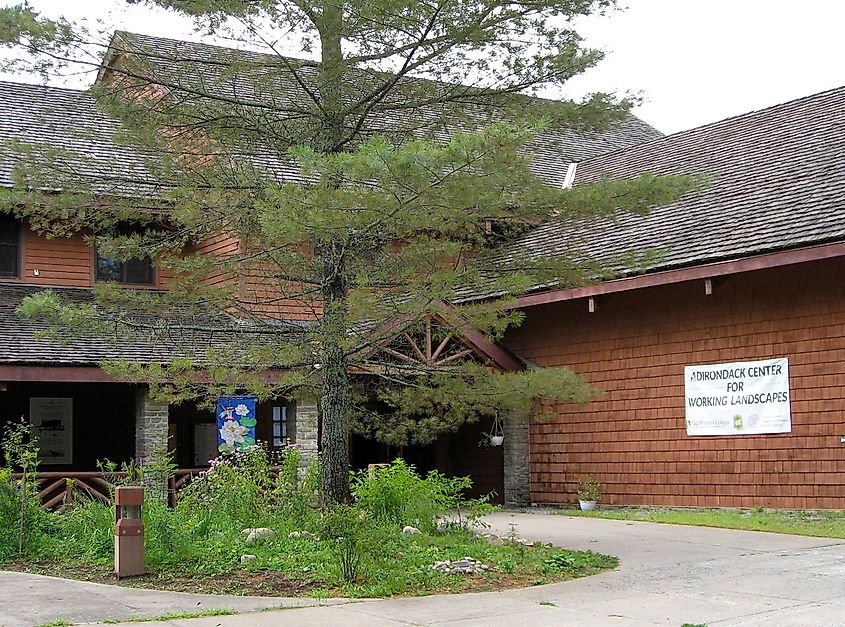
The hamlet of Paul Smiths is named after Paul Smith’s Hotel, which is now the location of Paul Smith’s College. The hotel, originally named Saint Regis House, was built by Apollos “Paul” Smith in 1859 and was one of the first major resorts in the Adirondack wilderness. As such, it hosted many great names, like P. T. Barnum, and several American presidents, including Theodore Roosevelt. Though it originally only had 17 rooms, it eventually grew to have 255 rooms, its own blacksmith, store, casino, and a bowling alley.
Paul Smiths is also now a good basecamp for visitors of the Six Nations Iroquois Cultural Center, which seeks to commemorate and preserve the crucial historical contributions of the Haudenosaunee (Six Iroquois Nations Confederacy) in Adirondack history. Arguably the first documented participatory democracy anywhere and an example for the new US government, the members of the Haudenosaunee are the Mohawks, the Senecas, the Onondagas, the Oneidas, the Cayugas, and the Tuscaroras.
The center is built in the style of a peaked-ceiling Haudenosaunee bark house from local trees milled at the local mill, and decoration is done in the Haudenosaunee style as well. It houses exhibits of a variety of artifacts from both before and after European contact. These include beaded belts, canoes, baskets, beadwork, clothing, and feathered headgear.
Keeseville
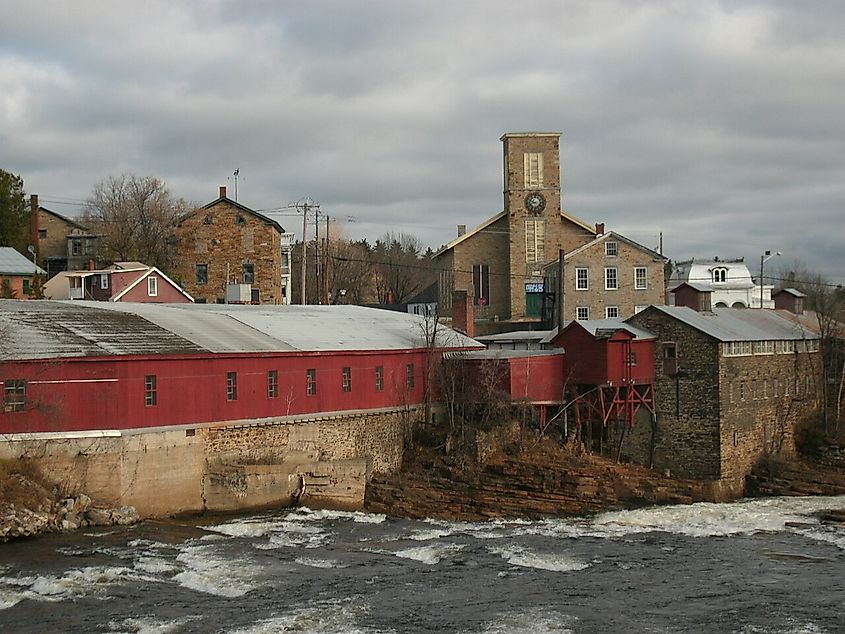
The hamlet of Keeseville was started in 1812 as an industrial community. It is now home to 147 historical structures, including buildings and bridges. The explorer and painter William Henry Jackson, known for his photographs of the frontier America, was born here.
Just outside of Keeseville is one of the oldest attractions on the continent: Ausable Chasm. Often called "the Grand Canyon of the Adirondacks," it was established as a tourist stop in 1870 and still captivates visitors with its untouched forests, striking natural features, and geologic formations. Visitors can experience it year-round, with climbing and boating in warmer months and snowshoeing and skiing in the winter.
Another important stopping point near Keeseville is the North Star Underground Railroad Museum. Found in the Chesterfield Heritage Center, it documents the Champlain Line of the Underground Railroad, which included Lake Champlain, the Champlain Canal, and the upper part of the Hudson River. The Champlain Line helped survivors of slavery on their way to Québec and Ontario in Canada. The Museum seeks to preserve and pass on some of their harrowing stories. It also educates on the historical debate over slavery, information on safe houses, and the anti-slavery movement.
Essex
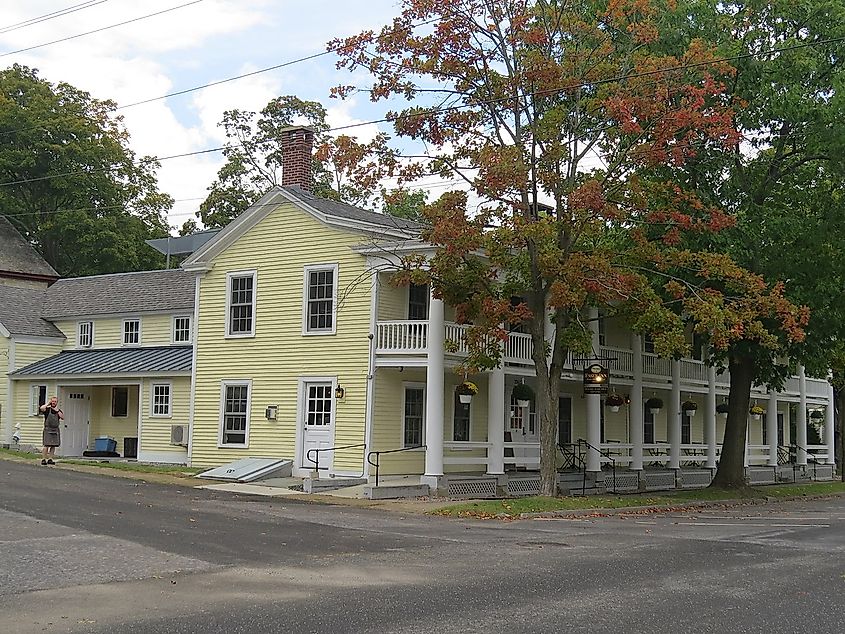
North of Ticonderoga on the shores of Lake Champlain is the town of Essex, once the lake’s busiest port for traffic of timber, cattle, iron, and more between New York City and Montreal. Sometimes referred to as "New York’s most historic hamlet," it still has some of the best examples of architecture from before the Civil War. Many of the town’s 19th-century churches, shops, and homes, such as the popular Cupola House and Cottage, are now on the National Register of Historic Places.
The most historic building in town is the Essex Inn on the Adirondack Coast, built in 1810 and is, therefore, the longest-lasting such establishment in the area. During the booming shipping days, the inn was an important social fixture. During the War of 1812, spies were known to have spent time there in order to gather intelligence.
With time and growth, an addition to the original Federal-style gave it more of the look of a Grecian temple. An 11-column colonnade in the Greek revival style was added around 1835.
In 2010, new owners began a series of major renovations, including new heating and electrical, commercial kitchen, new suites, and landscaping, resulting in the Inn’s fresh new look.
Lake Placid

Lake Placid is world-famous for hosting the Winter Olympics twice, in 1932 and 1980, and the 2023 FISU World University Winter Games. Understandably, athletes still flock to the Olympic facilities there.
Confusingly, the town of Lake Placid is located on Mirror Lake, not the lake named Lake Placid. The first European settlement there in 1800 had to be abandoned due to poor crops. Settlers tried again in the 1840s, and by the end of the century, it had established itself as a popular summer vacation destination, thanks to the founding of the Lake Placid Club by library legend Melvil Dewey in 1895. Dewey convinced vacationers to return to his resort in the winter, the first of its kind in the country.
Many may also recognize the town’s name from its place in pop culture. It had been a filming location since 1926, been name-checked by Cary Grant, and gave its name to a 1999 horror/action film as well.
For those interested in diving into local history, a former railroad depot now houses the Lake Placid-North Elba Historical Society Museum.
The current towns in the Adirondacks are set up to do what people there have been doing for millennia: take advantage of the area’s stunning natural resources. Whether that is the spectacular forests, crips and clear mountain air, or navigable lakes, the Adirondacks continue to be an escape for countless people at all times of the year. Once a hotly contested shipping route and site of terrible battles has been transformed into a place of leisure and enjoyment for many. But there are plenty of places where the history of the area can be learned about, and remembered.











